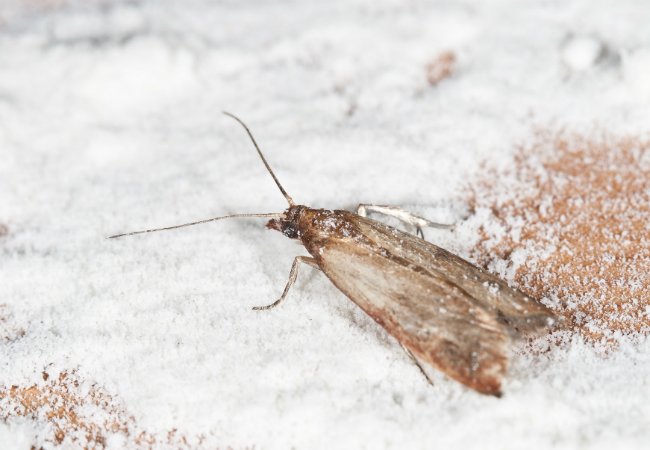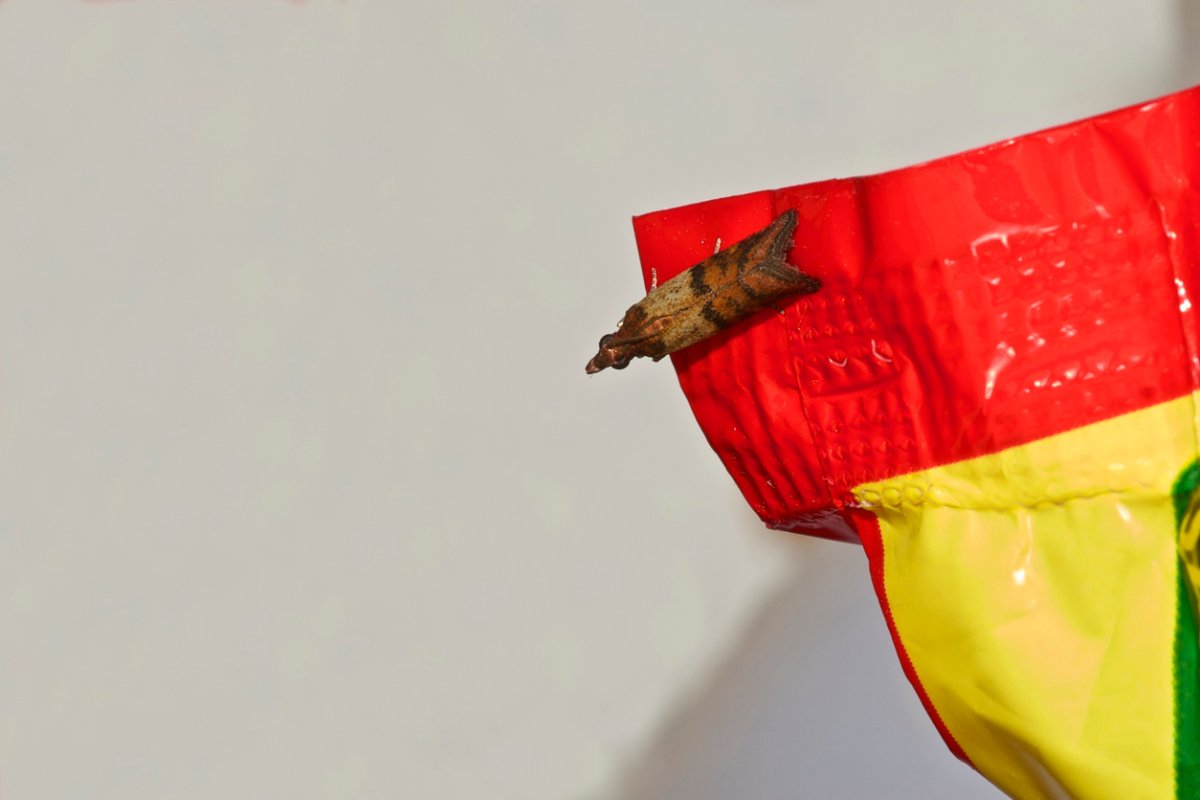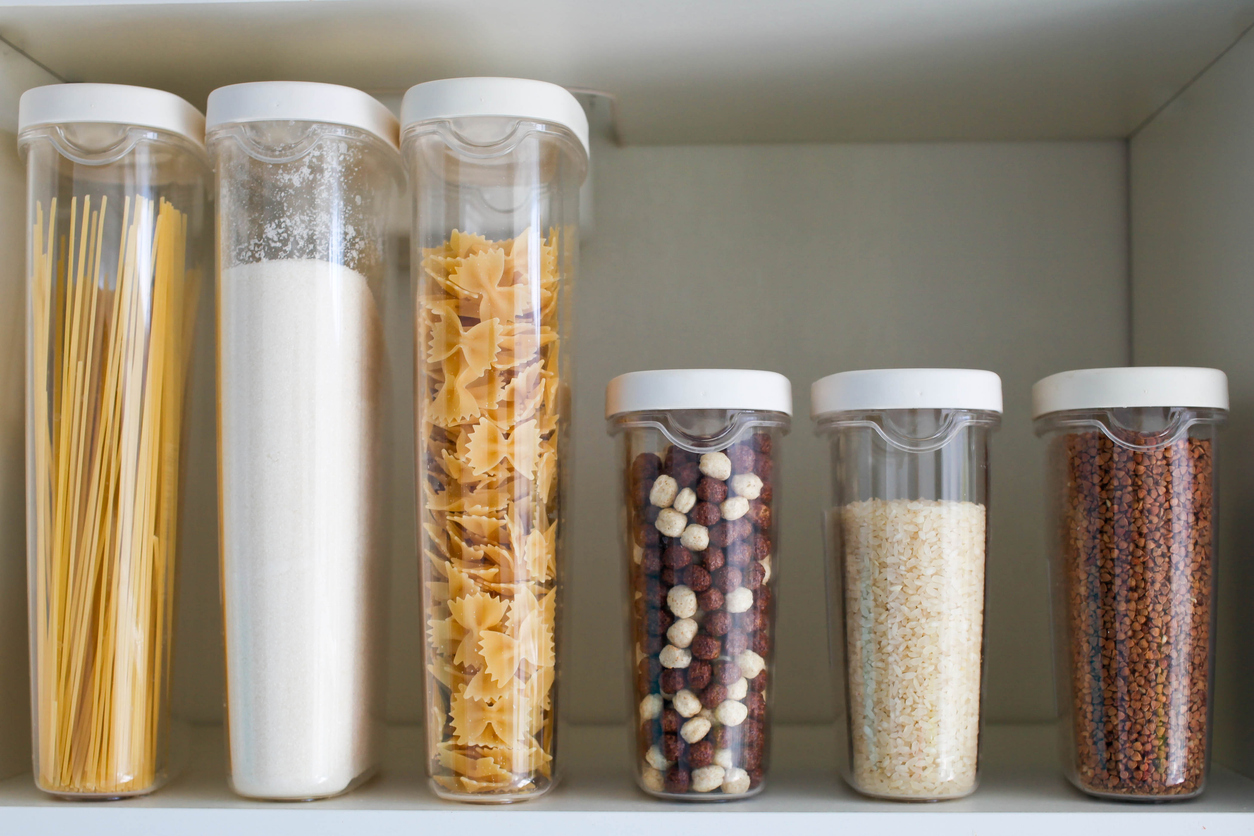

We may earn revenue from the products available on this page and participate in affiliate programs. Learn More ›
Sometimes known as cupboard moths, pantry moths “are often introduced into the home in the grain products we buy,” says James Agardy, an associate certified entomologist and Technical and Training Manager at Viking Pest Control, an extermination service that serves New Jersey, Pennsylvania, Delaware, and Maryland.
If you suspect a pantry moth infestation, act fast before they eat through the food in your kitchen. Take the steps below to address the pesky invaders, because even a minor problem can escalate quickly.
What are pantry moths?
Also known as Indian meal or Indianmeal moths, pantry moths are related to closet moths and are just as destructive in another part of the house. They can wreak havoc on your food supply in short order. Plodia interpunctella are particularly drawn to dried foodstuffs such as grains, spices, pasta, and dried fruits. “The larva feeds on all kinds of grain and grain-based products like pasta, baking mixes, pet food, bird seed” and the like, says Agardy.
Adult pantry moths are about ⅝-inch long and they sport bi-colored dirty white and copper-red wings. Voracious pantry moth larvae are about ½-inch long and have a brown head and dirty-white body. The pupae are ⅓- to ½-inch-long, whitish cocoons. Their flattened, white eggs are quite tiny and hard to spot with the naked eye.
The pantry moth life cycle starts when females typically lay their 40 to 350 eggs on or near food or food packaging. While adult pantry moths flit throughout the house or garage quite a bit, they are certainly not welcome in the home. However, they are not directly harmful to humans in that they don’t bite or transmit diseases. “The adult stage of the pest is lacking mouthparts and cannot feed,” says Agardy.
How to Identify a Pantry Moth Infestation

“Signs of infestation include the presence of adults and larvae, pupal cases (web-like cocoons), and damaged grain products,” explains Agardy. Another early sign of a pantry moth infestation is sightings of the adult moths flitting around your house or garage. If you see moths with the distinctive copper-red and dirty white wings, it’s time to dig a little deeper.
Inspect your pantry or cupboards for webs near dry goods and small holes in packaging. You may spot the pupae in their cocoons, attached to the side of a bag of flour, for example. Also look for the larvae—the life cycle stage that does the most damage—which “are most often found in infested products but will also be found crawling around cabinets and on surfaces while they try to find a location to pupate and transform into the adult life stage,” Argady says.
Double-check unsealed bags of dry goods for the larvae. “They often leave extensive webbing on the surface of the product they are feeding on,” according to Argady. You may also see frass, which Argady says “is chewed food particles that resemble small granules (think grains of sand).”
How to Get Rid of Pantry Moths

A small infestation can rapidly evolve into a massive invasion if left untreated, so it’s important to address the problem immediately by following these steps for how to get rid of moths in pantry areas, and in other parts of the kitchen.
Step 1: Empty the pantry and inspect its contents.
Empty out the affected area completely. Remove every can, box, bag, and bottle. Along the way, as you consider how to get rid of moths in the kitchen, look for larval sacs (or webs of any sort) on pantry shelves, and in all the nooks and crannies of your pantry or cupboard.
Step 2: Inspect pantry contents and dispose of non-airtight containers.
As you remove items, inspect them carefully. Keep an eye out for small holes in packaging. Remember that you’re pursuing not only the pantry moths themselves, but also other stages in the insect’s life cycle. So check under the lids of jars; moths are known to lay eggs here.
Dispose of any dry goods with open packaging. And definitely throw away any boxes or bags found to have holes you didn’t make. Put discarded items in plastic garbage bags, seal them up tightly, and then take them to an outside trash can immediately. You can keep jars that have been kept in an affected area, but empty their contents and use a scrub brush to wash the jars with hot, soapy water.
“[Professional] treatment is typically unnecessary or not recommended, as applying products to food items is not advisable,” according to Scot Hodges, associate certified entomologist at Arrow Exterminators, a pest control company with offices in Arizona and in several southeastern states.
Step 3: Vacuum the area.
Vacuum every square inch of the pantry. (Removing shelves, if you can, makes vacuuming easier.) Once you are finished, empty the vacuum bag, throw it in the trash, and take the garbage outside. If your vacuum is bagless, thoroughly wash and dry the canister.
After vacuuming, wash the affected area with a 50:50 solution of vinegar and warm water. If you have any on hand, add peppermint oil into the mixture. Pantry moths hate peppermint.
Step 4: Mop the floor with a vinegar-and-water solution.
Finish cleaning the area by carefully mopping the floor with the same 50:50 mixture of vinegar and warm water, and then clean your mop head after you’re finished. First, thoroughly rinse the mop head under running water. Then, you can immerse the mop head in a gallon of water mixed with ½ cup of bleach, or, if you have a string mop, you can simply toss it in the washing machine.
Step 5: Don’t restock the pantry right away.
Wait a few weeks before restocking the area you’ve cleaned. You’ll need to replace your food items, of course, but you’re better off storing them in a different place until you can ascertain the pantry is truly moth-free.
If you find more insect activity, repeat the steps above, this time widening the scope to adjacent shelves and cabinets. Check the new food you’ve purchased. Unless you have reason to suspect you’ve brought in a fresh infestation from the outside, you shouldn’t have to toss the food you purchased to replace what you have already lost.
How to Prevent Pantry Moths

Once you’ve successfully gotten rid of pantry moths, it’s helpful to know how to repel pantry moths and how to get rid of pantry moths forever. The good news is that it just takes a few steps to keep them away. Start with storage. “To keep reinfestation from taking place, food products containing grain should be stored in airtight containers like Tupperware,” says Argady. “This coupled with proper sanitation can keep your home moth-free.”
- Store dry goods in plastic or glass food storage containers with airtight seals.
- Leave peppermint, bay leaves, mint, or cedar chips exposed within the area, perhaps in a sachet.
- Inspect your cabinets and pantry on a regular basis. If you spot pantry moths, always act quickly in order to limit their spread as much as possible. After all, it’s easier to clean a single cabinet than it is to clean every food cabinet.
Finally, it’s worth mentioning that pantry moths often piggy-back home with you from the grocery store. Before purchasing flour, cereal, bread, or pet food, scrutinize the packaging. Leave any suspect packaging right there on the shelf. Hodges warns that if you notice moths flying around the pet food aisle, it might be best to purchase your dog food at a different store.
FAQs
The pantry moth life cycle can range anywhere from 27 to 305 days.
Left untreated, a pantry moth infestation can last indefinitely, cycling through four to six generations each year. If you use an active treatment regimen, you’ll probably be rid of them in a couple months.
“Pantry moths do not have a traditional nest,” says Hodges, “but identifying infested food requires inspecting items not stored in jars or cans.” As you search for signs of pantry moths, Hodges says: “Remember to inspect items stored on the out-of-sight top shelf, as they are often forgotten.” He also recommends checking recent purchases, as they may be the source of the moths. “Additionally, older, forgotten food items are also susceptible to infestation,” he adds.
